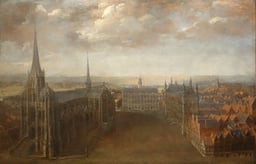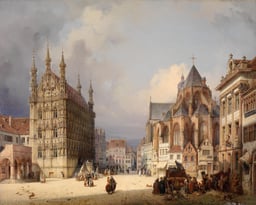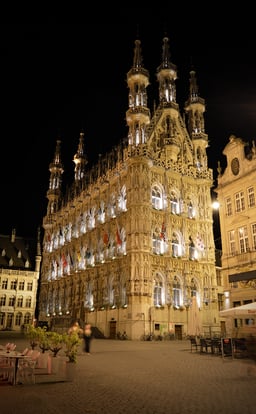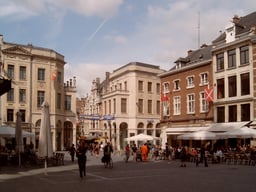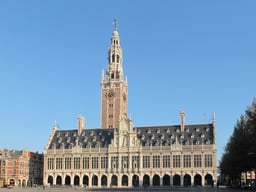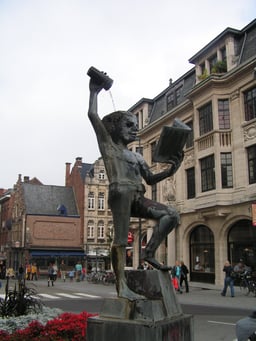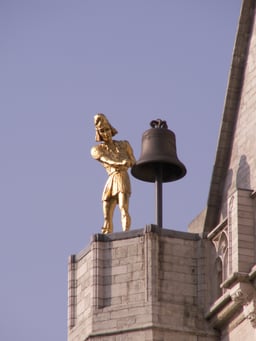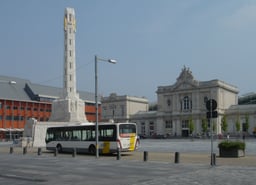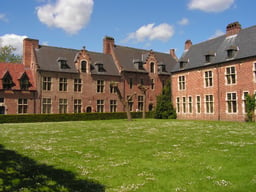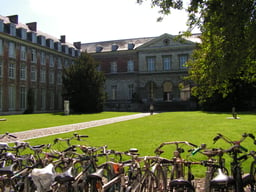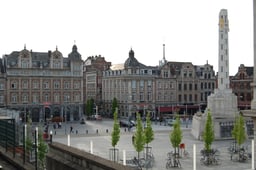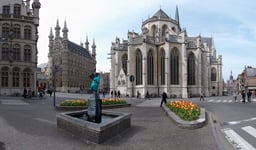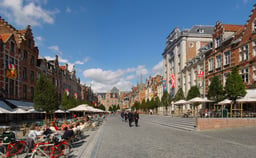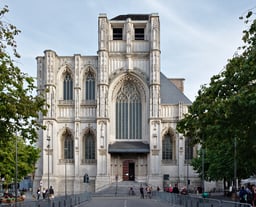Leuven
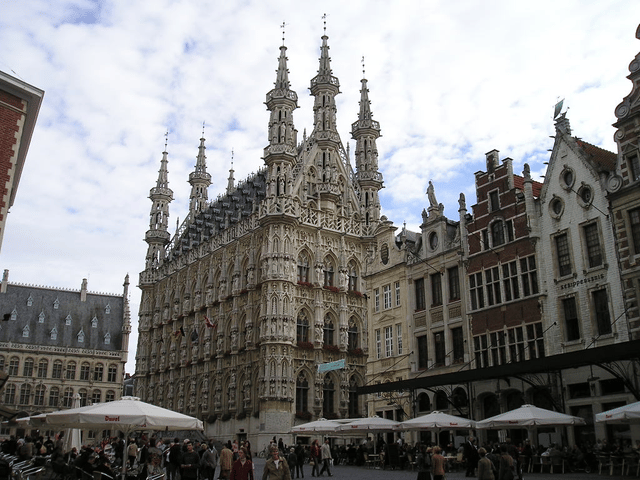
Leuven

Leuven | |
|---|---|
Municipality | |
| Coordinates:50°53′N 04°42′E [39] | |
| Country | Belgium |
| Community | Flemish Community |
| Region | Flemish Region |
| Province | Flemish Brabant |
| Arrondissement | Leuven |
| Government | |
| • Mayor | Mohamed Ridouani (sp.a) |
| • Governing party/ies | SP.A, Groen, CD&V |
| Area | |
| • Total | 56.63 km2(21.86 sq mi) |
| Population (2018-01-01)[1] | |
| • Total | 101,396 |
| • Density | 1,800/km2(4,600/sq mi) |
| Postal codes | 3000, 3001, 3010, 3012, 3018 |
| Area codes | 016 |
| Website | www.leuven.be [40] |
Leuven (/ˈlɜːvən/, Dutch: [ˈløːvə(n)] (listen)) or Louvain (/luːˈvæ̃/, also US: /luːˈveɪn/, French: [luvɛ̃]; German: Löwen [ˈløːvn̩] (listen)) is the capital of the province of Flemish Brabant in Belgium. It is located about 25 kilometres (16 miles) east of Brussels. The municipality itself comprises the historic city and the former neighbouring municipalities of Heverlee, Kessel-Lo, a part of Korbeek-Lo, Wilsele and Wijgmaal. It is the eighth largest city in Belgium and the fourth in Flanders with more than 100,244 inhabitants (Federal Ministry of Home Affairs, 1/11/2016).
KU Leuven, Belgium's largest university, has its flagship campus in Leuven, which has been a university city since 1425.[2] This makes it the oldest university city in the Low Countries. The city is also known for being the headquarters of Anheuser-Busch InBev, the world's largest beer brewer[3] and sixth-largest fast-moving consumer goods company.[4]
Leuven | |
|---|---|
Municipality | |
| Coordinates:50°53′N 04°42′E [39] | |
| Country | Belgium |
| Community | Flemish Community |
| Region | Flemish Region |
| Province | Flemish Brabant |
| Arrondissement | Leuven |
| Government | |
| • Mayor | Mohamed Ridouani (sp.a) |
| • Governing party/ies | SP.A, Groen, CD&V |
| Area | |
| • Total | 56.63 km2(21.86 sq mi) |
| Population (2018-01-01)[1] | |
| • Total | 101,396 |
| • Density | 1,800/km2(4,600/sq mi) |
| Postal codes | 3000, 3001, 3010, 3012, 3018 |
| Area codes | 016 |
| Website | www.leuven.be [40] |
History

Leuven on the Ferraris map (around 1775)

View over Leuven, late 19th century
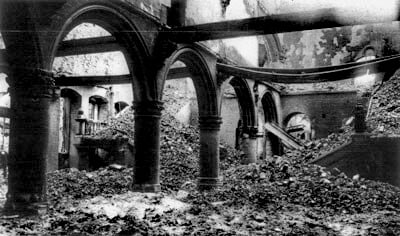
Destruction of the university library, 1914
The earliest mention of Leuven (Loven) dates from 891, when a Viking army was defeated by the Frankish king Arnulf of Carinthia (see: Battle of Leuven). According to a legend, the city's red and white arms depict the blood-stained shores of the river Dyle after this battle, similarly to Austria’s Flag.
Situated beside this river, and near to the stronghold of the Dukes of Brabant, Leuven became the most important centre of trade in the duchy between the 11th and 14th centuries. A token of its former importance as a centre of cloth manufacture is shown in that ordinary linen cloth was known, in late-14th-century and 15th-century texts, as lewyn (other spellings: Leuwyn, Levyne, Lewan(e), Lovanium, Louvain).[5]
In the 15th century, a new golden era began with the founding of what is now the largest and oldest university in the Low Countries, the Catholic University of Leuven, in 1425.[6]
In the 18th century, the brewery Den Horen (meaning "the horn") flourished. In 1708, Sebastien Artois became the master brewer at Den Horen, and gave his name to the brewery in 1717, now part of AB InBev, whose flagship beer, Stella Artois, is brewed in Leuven and sold in many countries.
Leuven has several times been besieged or occupied by foreign armies; these include the Battle of Leuven (891), Siege of Leuven (1635) and Battle of Leuven (1831).
In the 20th century, both world wars inflicted major damage upon the city. Upon Germany's entry into World War I, the town was heavily damaged by rampaging soldiers.[7] In all, about 300 civilians lost their lives.[8] The university library was also destroyed on 25 August 1914, using petrol and incendiary pastilles.[9][10] 230,000 volumes were lost in the destruction, including Gothic and Renaissance manuscripts, a collection of 750 medieval manuscripts, and more than 1,000 incunabula (books printed before 1501).[10][11] The destruction of the library shocked the world, with the Daily Chronicle describing it as war not only against civilians but also against "posterity to the utmost generation."[12] It was rebuilt after the war, and much of the collection was replaced. Great Britain (on the initiative of the John Rylands Library in Manchester) and the United States were major providers of material for the replenishment of the collection.[8] The new library building was financed by the National Committee of the United States for the Restoration of the University of Louvain and built to the design of architect Whitney Warren; it was officially opened on 4 July 1928.[13] Richard Harding Davis, a war correspondent for the New York Tribune, was in Leuven (or Louvain, in Davis' account) and wrote a column titled "The Germans Were Like Men After an Orgy" in which he described the organized civilian murders and vandalism committed by the occupying troops.[14]
In World War II, after the start of the German offensive, Leuven formed part of the British Expeditionary Force's front line and was defended by units of the 3rd Division and Belgian troops. From 14 to 16 May 1940, the German Army Group B assaulted the city with heavy air and artillery support. The British withdrew their forces to the River Senne on the night of 16 May and the town was occupied the next day.[15] The new university library building was set on fire by shelling, on 16 May, and nearly a million books were lost.[16]
Climate
| Climate data for Leuven (1981–2010) | |||||||||||||
|---|---|---|---|---|---|---|---|---|---|---|---|---|---|
| Month | Jan | Feb | Mar | Apr | May | Jun | Jul | Aug | Sep | Oct | Nov | Dec | Year |
| Average high °C (°F) | 5.9 (42.6) | 6.8 (44.2) | 10.6 (51.1) | 14.4 (57.9) | 18.5 (65.3) | 21.1 (70.0) | 23.5 (74.3) | 23.2 (73.8) | 19.5 (67.1) | 15.1 (59.2) | 9.8 (49.6) | 6.3 (43.3) | 14.6 (58.3) |
| Daily mean °C (°F) | 3.2 (37.8) | 3.5 (38.3) | 6.6 (43.9) | 9.5 (49.1) | 13.5 (56.3) | 16.2 (61.2) | 18.4 (65.1) | 18.0 (64.4) | 14.9 (58.8) | 11.1 (52.0) | 6.8 (44.2) | 3.8 (38.8) | 10.5 (50.9) |
| Average low °C (°F) | 0.5 (32.9) | 0.4 (32.7) | 2.7 (36.9) | 4.4 (39.9) | 8.4 (47.1) | 11.3 (52.3) | 13.4 (56.1) | 12.8 (55.0) | 10.2 (50.4) | 7.3 (45.1) | 3.9 (39.0) | 1.4 (34.5) | 6.4 (43.5) |
| Average precipitation mm (inches) | 70.5 (2.78) | 59.5 (2.34) | 65.4 (2.57) | 50.0 (1.97) | 63.6 (2.50) | 70.4 (2.77) | 72.7 (2.86) | 71.3 (2.81) | 64.8 (2.55) | 71.9 (2.83) | 70.6 (2.78) | 76.1 (3.00) | 806.8 (31.76) |
| Average precipitation days(≥ 1 mm) | 12.6 | 10.9 | 12.9 | 9.9 | 11.3 | 10.7 | 10.4 | 10.2 | 10.6 | 11.1 | 11.9 | 12.7 | 135.2 |
| Mean monthly sunshine hours | 56 | 74 | 119 | 170 | 202 | 197 | 210 | 200 | 143 | 118 | 63 | 46 | 1,597 |
| Source: KMI/IRM[17] | |||||||||||||
Economy
Given the presence of the KU Leuven, Europe's most innovative university according to Reuters,[18] much of the local economy is concentrated on spin-offs from academic research. In addition, the Leuven-based research centre, IMEC, is a world class research centre in the field of nano-electronics and digital technologies.[19] As a result, dozens of companies in high technological fields such as biotech, robotics, additive manufacturing and IT, are located near these research institutes on the Arenberg Science Park and Haasrode Research-Park. Quite a few international companies such as Siemens,[20] Huawei,[21] Nitto Denko, JSR Corporation [41] or Commscope [42] have important, often research oriented branches, in Leuven. The academic hospital UZ Leuven, [1] [43] is another advanced research institute. It is one of Europe's largest and most advanced academic hospitals. As a result, large numbers of private service providers are active in the medical, financial and legal fields.
Because it is the capital of the region of Flemish Brabant, many governmental institutions are located in Leuven, as well as the regional headquarters of transport corporations such as De Lijn. As one of Flanders Art-Cities,[22] with a large range of cafés, restaurants, cultural institutions and shopping neighbourhoods, Leuven also attracts a fair share of tourists.
Leuven is the worldwide headquarters of Anheuser-Busch InBev, the largest beer company in the world and is considered one of the largest fast-moving consumer goods (FMCG) companies in the world. InBev's Stella Artois brewery and main offices dominate the entire north-eastern part of the town, between the railway station and the canal to Mechelen.
Demographics
As of 1 November 2016, the population of Leuven was 100,244. The arrondissement of Leuven counted 494,189 in 2014.
The city itself is made up out of the centre of Leuven (30,313), Kessel-Lo (29,147), Heverlee (22,521), Wilsele (9,786) and Wijgmaal (3,592).
Student population
Nowadays, Leuven has a large Dutch-speaking student population (with more than 55,000 students enrolled in 2014–15), mainly concentrated around the city centre. The Katholieke Universiteit Leuven (KU Leuven; University of Leuven) is the oldest Catholic university still in existence in the world, and the largest university in Belgium. There are also a number of hogescholen (universities of applied sciences, literally translated: "high schools"), such as the UCLL [44] (the UC Leuven-Limburg).
Transport
Within the city and its immediate surroundings, most distances can be covered on foot or with a bicycle. Several streets are off-limits to vehicle traffic and, within the city centre, road speed regulations prescribe 30 km/h (19 mph) as the maximum speed limit, making it a pedestrian and bicycle-friendly city. There are also a few car parking lots.
There are numerous buses, primarily from the public transport company De Lijn, that connect the city with the region while providing travel options within the city centre. The so-called Ringbus follows the ring road of the city. Except for long distance routes (such as to other cities) and other irregular bus services, most buses come by every 10 minutes. Buses 616, 652 and 651 connect Leuven with Brussels Airport.
Leuven railway station is located on the NMBS railway lines 35 (Leuven–Aarschot–Hasselt), 36 (Brussels–Liège), 36N (Schaarbeek–Leuven), 53 (Schellebelle–Leuven), and 139 (Leuven–Ottignies). In Bierbeek, south-east of Leuven, lies the beginning of HSL 2, the high-speed railway towards Liège.
The European route E40 passes Leuven in the south, the European route E314 connects Leuven with the city of Aachen.
Politics
Mayor
The governing coalition of Leuven consists of SP.A (14 out of 47 seats), Groen (10 seats) and CD&V (8 seats), with SP.A providing the mayor with Mohamed Ridouani. The opposition is composed of N-VA (11 seats), open VLD (2 seats), PVDA (1 seat) and Vlaams Belang (1 seat).[23]
Culture
One of Belgium's conservatories is based in Leuven: the Lemmens Institute, which is described as "Faculty of Music, Performing Arts and Education". It is known for its Music Therapy Education and its Wordart-Drama Education. Kunstencentrum STUK is a cultural centre and venue in the city center for music, theatre, sound art, and dance. Leuven is well known for its summer rock festival, Marktrock. Leuven also has some famous university orchestras, such as the University Symphony Orchestra (USO),[24] the University Symphonic Band (UGO).[25] and the Arenberg Orchestra[26][27]
In September 2009, the 'M – Museum Leuven' opened in Leuven. It is a museum for both contemporary and historical art, located near het Ladeuzeplein. It has hosted exhibitions by international artists such as Angus Fairhurst, Sol LeWitt, Roe Ethridge and Charles Burns as well as Belgian artists such as Ilse D'Hollander, Jan Vercruysse, Antoon Van Dyck and Freek Wambacq.
Leuven also has a rich beer culture, being the birthplace of several beers such as Stella Artois,[6] Leuvense Tripel, Domus[6] and Keizersberg. It also has several bars priding themselves in offering a wide variety of local and international beers, including a bar that claims to offer more than 3000 different beers.
The Higher Institute of Philosophy is famous worldwide for the archives of the German philosopher Edmund Husserl.
Sport
The main football club of the municipality is Oud-Heverlee Leuven, successor of Stade Leuven. The city's prime basketball team are the Leuven Bears. They play their home games in the SportOase. The Cyclocross Leuven is a cyclo-cross race held in January.
Buildings and landmarks
Secular
The Town Hall, built between 1439 and 1463 by Sulpitius van Vorst, Jan II Keldermans, and following their death, Matheus de Layens, in a Brabantian late-Gothic style. In the 19th century, 236 statues were added to the exterior, each representing a prominent local scholar, artist or noble from the city’s history. The reception hall dates from 1750.
Arenberg Castle was originally built in 16th century in the Renaissance style and was extensively renovated in the Neogothic style in the 19th century. The duke of Arenberg donated the domain to the Katholieke Universiteit Leuven in 1916. It is open to the public. It has a beautiful green park outside with gardens. Eggs of wild ducks can be seen around the park.
The Linen-hall, in an early-Gothic style, with baroque addition, is today the University Hall.
The University Library on the Ladeuzeplein was built by the American architect Whitney Warren. It was a gift from the American people to Leuven after World War I, during which the Germans burned down the original library. The tower houses one of the largest carillons in the world.
The 'Oude Markt' or Old Market square located in the centre of Leuven features a vibrant social scene, the centre of which displays a life-size statue of 'De Kotmadam', or "The Landlady" resting on a bench.
Sint-Donatus Park contains remains of the medieval city wall.
'Totem' is a statue at the centre of the Ladeuzeplein; it is a work of the Belgian artist Jan Fabre. Featuring a 23-metre-high needle impaling a giant jewelled beetle, the statue towers over the square in front of the university library.
'Fonske' is a statue near the centre of town. Its full name is Fons Sapientiae, Latin for "fountain of wisdom". The statue represents a university student who, while reading a book, lets wisdom flow into his head as liquid from a glass. Just like Manneken Pis in Brussels, Fonske is, from time to time, dressed in costumes appropriate for specific occasions.
Religious
St. Peter's Church (1425–1500) was finished by Jan Keldermans and Matheus de Layens. During the Second World War, the church was damaged. During the restoration, a Romanesque crypt from the 11th century was found. In the church itself, there are several paintings from the 15th to 18th centuries (among which, Dirk Bouts' famous painting of the last supper) and the grave of Duke Henry I of Brabant. The 50-metre-high tower — which was meant to be 169 metres high, but was never completed — is home to a carillon. The tower was included in UNESCO's list of Belfries of Belgium and France in 1999.
Saint-Anthony's Chapel, Pater Damiaanplein, from the 17th to the 20th centuries, contains the tomb of Father Damien, the "leper priest" of Molokai, who was canonised by Pope Benedict XVI on Sunday 11 October 2009.[28][29] The Catholic Encyclopedia calls him "the Apostle of the Lepers",[30] and elsewhere, he is known as the "leper priest". The Catholic priest's remains were returned in Belgium with great fanfare in 1936, after having been originally buried on the Hawaiian Island of Molokai where he had served the outcast lepers until his death.
The Church of Saint Michael was built in the typical Jesuit Baroque Style.
The Saint Quentin's Church incorporates remains of a Romanesque church built in the 13th century.
The Large Beguinage is one of the world's best remaining examples of its architectural type. It was recognised by UNESCO as a World Heritage Site in 1998.
Park Abbey, a 42ha Premonstratensian Abbey founded in 1129 and manufacturing site of the Parc Abbey Bible. It is one of the best preserved abbey complexes in the Low Countries[31] and is still inhabited by a small community of Canons regular.[32]
Keizersberg Abbey, an active Neo-Romanesque Benedictine Abbey founded in 1888.[33] It is situated on the Keizersberg ("Emperor's Mountain") which used to be the location of a 12th-century ducal castle until it was demolished in 1782.
Vlierbeek Abbey, a former Benedictine abbey founded in 1127.
Sint-Geertrui Abdij, a former Augustinian abbey founded in 1206.
Lerkeveld is a Jesuit house, student residence, and headquarters of the Society of Jesus in Belgium.
There are several other smaller churches and chapels throughout the town.
Colleges
The Old University of Leuven used to have 40 constituent colleges and 4 pedagogies, some of which are still being used by KU Leuven. The most notable ones are:
Holy Ghost College, founded in 1442, currently a residence for theology students and priests at KU Leuven.
Collegium Trilingue, which promoted the teaching of Hebrew, Greek and Latin. It was founded in 1517 by the humanist Hieronymus Busleyden under impulse of Desiderius Erasmus and served as a model for France's Collège de France.
Pope's College, a college for theology students of the Old University of Leuven founded by Pope Adrian VI in 1523.
St Anthony's College, founded in 1607, was located on the Pater Damiaanplein and has been a centre of Irish learning on the European Continent since the early 17th century.The Leuven Institute for Ireland in Europe is now located on the premises.
International relations
Twin towns/sister cities
Leuven is twinned with:
[[INLINE_IMAGE|//upload.wikimedia.org/wikipedia/commons/thumb/2/20/Flag_of_the_Netherlands.svg/23px-Flag_of_the_Netherlands.svg.png|//upload.wikimedia.org/wikipedia/commons/thumb/2/20/Flag_of_the_Netherlands.svg/35px-Flag_of_the_Netherlands.svg.png 1.5x, //upload.wikimedia.org/wikipedia/commons/thumb/2/20/Flag_of_the_Netherlands.svg/45px-Flag_of_the_Netherlands.svg.png 2x|Netherlands|h15|w23|thumbborder flagicon-img flagicon-img]] 's-Hertogenbosch, Netherlands
[[INLINE_IMAGE|//upload.wikimedia.org/wikipedia/en/thumb/1/12/Flag_of_Poland.svg/23px-Flag_of_Poland.svg.png|//upload.wikimedia.org/wikipedia/en/thumb/1/12/Flag_of_Poland.svg/35px-Flag_of_Poland.svg.png 1.5x, //upload.wikimedia.org/wikipedia/en/thumb/1/12/Flag_of_Poland.svg/46px-Flag_of_Poland.svg.png 2x|Poland|h14|w23|thumbborder flagicon-img flagicon-img]] Kraków, Poland[34]
[[INLINE_IMAGE|//upload.wikimedia.org/wikipedia/en/thumb/b/ba/Flag_of_Germany.svg/23px-Flag_of_Germany.svg.png|//upload.wikimedia.org/wikipedia/en/thumb/b/ba/Flag_of_Germany.svg/35px-Flag_of_Germany.svg.png 1.5x, //upload.wikimedia.org/wikipedia/en/thumb/b/ba/Flag_of_Germany.svg/46px-Flag_of_Germany.svg.png 2x|Germany|h14|w23|thumbborder flagicon-img flagicon-img]] Lüdenscheid, Germany
[[INLINE_IMAGE|//upload.wikimedia.org/wikipedia/en/thumb/c/c3/Flag_of_France.svg/23px-Flag_of_France.svg.png|//upload.wikimedia.org/wikipedia/en/thumb/c/c3/Flag_of_France.svg/35px-Flag_of_France.svg.png 1.5x, //upload.wikimedia.org/wikipedia/en/thumb/c/c3/Flag_of_France.svg/45px-Flag_of_France.svg.png 2x|France|h15|w23|thumbborder flagicon-img flagicon-img]] Rennes, France
[[INLINE_IMAGE|//upload.wikimedia.org/wikipedia/commons/thumb/7/72/Flag_of_the_Republic_of_China.svg/23px-Flag_of_the_Republic_of_China.svg.png|//upload.wikimedia.org/wikipedia/commons/thumb/7/72/Flag_of_the_Republic_of_China.svg/35px-Flag_of_the_Republic_of_China.svg.png 1.5x, //upload.wikimedia.org/wikipedia/commons/thumb/7/72/Flag_of_the_Republic_of_China.svg/45px-Flag_of_the_Republic_of_China.svg.png 2x|Taiwan|h15|w23|thumbborder flagicon-img flagicon-img]] Tainan, Taiwan
Friendly relations
Aside from the aforementioned cities, Leuven has friendly relations with:
[[INLINE_IMAGE|//upload.wikimedia.org/wikipedia/commons/thumb/7/73/Flag_of_Romania.svg/23px-Flag_of_Romania.svg.png|//upload.wikimedia.org/wikipedia/commons/thumb/7/73/Flag_of_Romania.svg/35px-Flag_of_Romania.svg.png 1.5x, //upload.wikimedia.org/wikipedia/commons/thumb/7/73/Flag_of_Romania.svg/45px-Flag_of_Romania.svg.png 2x|Romania|h15|w23|thumbborder flagicon-img flagicon-img]] Cristian, Romania
[[INLINE_IMAGE|//upload.wikimedia.org/wikipedia/en/thumb/4/41/Flag_of_India.svg/23px-Flag_of_India.svg.png|//upload.wikimedia.org/wikipedia/en/thumb/4/41/Flag_of_India.svg/35px-Flag_of_India.svg.png 1.5x, //upload.wikimedia.org/wikipedia/en/thumb/4/41/Flag_of_India.svg/45px-Flag_of_India.svg.png 2x|India|h15|w23|thumbborder flagicon-img flagicon-img]] New Delhi, India[35]
[[INLINE_IMAGE|//upload.wikimedia.org/wikipedia/commons/thumb/a/af/Flag_of_South_Africa.svg/23px-Flag_of_South_Africa.svg.png|//upload.wikimedia.org/wikipedia/commons/thumb/a/af/Flag_of_South_Africa.svg/35px-Flag_of_South_Africa.svg.png 1.5x, //upload.wikimedia.org/wikipedia/commons/thumb/a/af/Flag_of_South_Africa.svg/45px-Flag_of_South_Africa.svg.png 2x|South Africa|h15|w23|thumbborder flagicon-img flagicon-img]] Stellenbosch, South Africa



